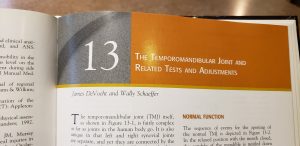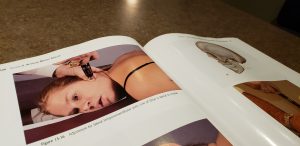Chiropractors are able to adjust many joints in the body, including the temporomandibular joint (TMJ) or jaw. Some patients wait for a jaw injury to occur, or a TMD (temporomandibular disorder), before seeking help. Other times Chiropractors notice improper jaw functioning and reflexes while testing the body as a whole.
What is TMD?
Temporomandibular disorders is a name given to jaw problems.
These problems can present in many different ways. In my Caledonia Chiropractic practice I have seen the a jaw problem create:
-tooth pain
-eye pain
-sinus pain
-tinnitus or ringing in the ear
-vertigo
-neck pain
-offset biting and chewing
-biting the cheek or lips when eating (I have patients who notice that their jaw is out of position when they start biting their lip, tongue, or cheek. If this is happening to you, it is probably the jaw moving incorrectly. Time to get checked by a Chiropractor.)
-clicking
-jaw stuck
-improper jaw tracking
-headaches
-postural distortions
These TMDs can occur like any injuries. There is usually a physical injury at one point in a patient’s life, but then the injury can recur very easily through life habits and stresses. The jaw is directly susceptible to stress as we often grind our teeth when under stress, even subconsciously.
Dentists will often notice that a patient is grinding their teeth because their teeth are wearing out. If this is the case, they often prescribe a mouth guard to assist. This does address the teeth grinding each other, but often times the jaw can still be irritated by the clenching.
What is the TMJ?
TMJ refers to the jaw joint or temporomandibular joint.
Do Chiropractors adjust the jaw?
Yes, Chiropractors do adjust the jaw.
How do Chiropractors adjust the jaw?
There are many ways to adjust the jaw and help a person who is suffering with jaw problems.
Dr. Callum Peever is advanced proficient in using the Activator Methods Chiropractic Technique, which can directly and indirectly adjust the jaw to assist. The activator contacts the the jaw bone and does a quick yet gentle movement to reset the positioning and reflexes associated with the joint. This can help reset the TMJ muscles, ligaments, and positioning. The adjustment is often necessary over days, weeks, or even months in order to encourage the jaw to stay in the best position or if the problem is stubborn.
Here are some pictures from the Activator Method 2nd Edition textbook by Dr. Arlan Fuhr highlighting the chapter on adjusting the TMJ for Chiropractic students to learn.



I just recently listened to Dr. Fuhr discuss adjusting the TMJ utilizing an Activator with Dr. Shepherd (“Dr. Fuhr & Dr. Shepherd Dive Deep into What The Activator Method Can Do For TMJ Patients“). Check the other episodes out at Activate Your Practice.
Where can I read more about adjusting the TMJ?
Here are some research papers to explore more about Chiropractic and adjusting the jaw:
Chiropractic Treatment of Temporomandibular Dysfunction: A Retrospective Case Series
What can I do at home to help my jaw?
I often teach patients to feel for the tension in their jaw muscles with their fingers as they get to understand their jaw problem. It can greatly help the patient understand where they are clenching and to reduce the pain related to the muscle trigger points. If the jaw is not tracking well however, the adjustment most likely is necessary.
Contact us today in Caledonia for help with your Jaw – 905-765-4025
